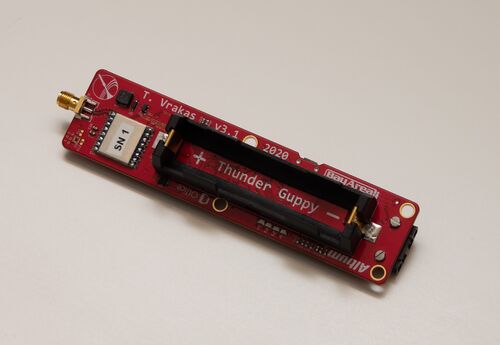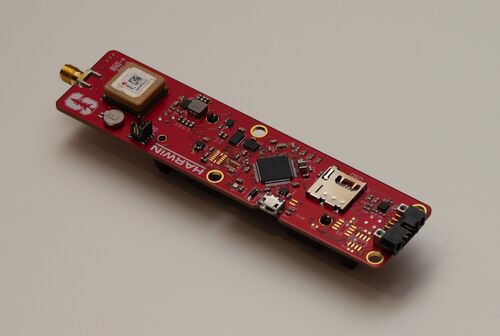ThunderGuppy
ThunderGuppy is the third generation of SSI rocket flight computer. It's hardware was developed in 2020 by Tim Vrakas. ThunderGuppy followed the SkyBass and SpaceSalmon, making the naming scheme O-Fish-ial. ThunderGuppy was the smallest generation of the family to date, and was designed to fit as a standalone module into a standard 2" airframe, much like the Stratrologger and Raven COTS Altimeters.
Hardware Features
From the start, ThunderGuppy was designed to be mostly compatible with the earlier SpaceSalmon. Aside from the major change to form factor, Guppy introduced the following changes:
- Integrated S6C Radio and GPS hardware, in place of an add-on RF carrier module needed for SpaceSalmon.
- Two FET-based squib drivers, in place of the MC33797 4-channel squib driver IC. These are not designed to safely control high-risk initiators, but decrease complexity.
- A single 18650 Li-Ion cell. This was needed to satisfy the form factor requirement.
- Dual accelerometer banks, each with high and low range 3-axis sensors. This allows emulation of a high-range gyroscope by indirect measurement of centripetal acceleration.
Brains:
- SAME51J20A (TQFP 64) CPU
Sensors:
- 2x BMI088 6 Axis Accel/Gyro (up to 24G, 2000deg/s)
- 2x BMP388 Pressure/Temperature
- 2x ADXL375 3 Axis Accel (up to 200G)
Power:
- 18650 Li-Ion cell
- 3.3v buck-boost converter, over 90% efficient
Misc:
- Micro SD card slot
- PFET squib driver, for E-Match pyrotechnic charges
- CAN Transceiver (not implemented)
- RS-485 Transceiver (not implemented)
The schematics and board designs are avialable here
Software
ThunderGuppy Inherits its codebase from SpaceSalmon, with several modifications to support Guppy specific hardware features. The code lives here: SpaceSalmon The code can be built by selecting the `guppy` target in PlatformIO. An overview of the codebase was presented within SSI, using the slides here

